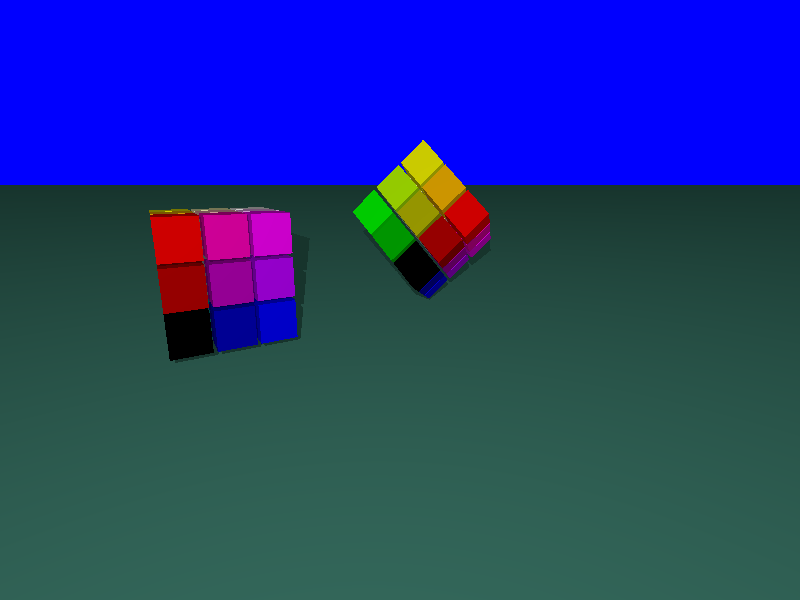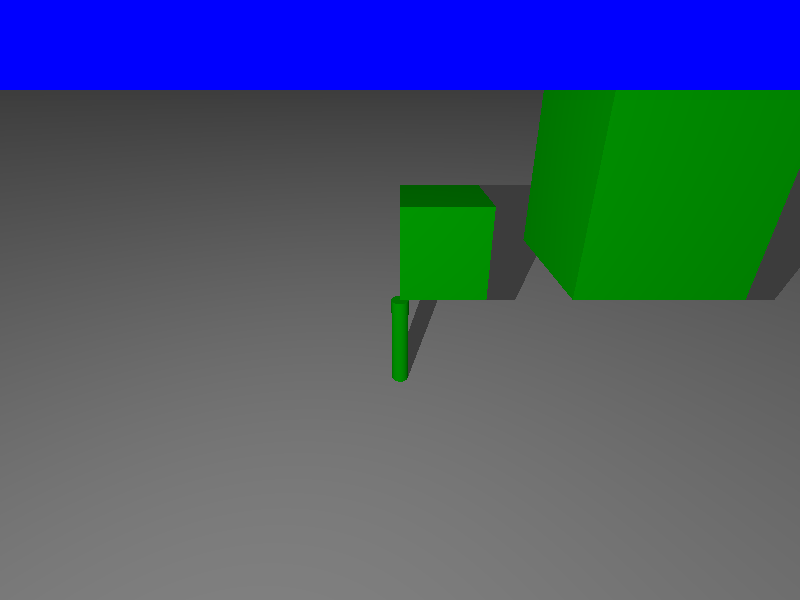Genealogy and Compounds¶
Now, you are able to position objects individually. However, usually, you need to move the objects in groups, like a watch which moves with the arm of a person or like all the parts of your bike when you move the bike.
In pycao, there are two ways to aggregate the objects: a genealogy relationship parent/childre or a compound aggregate. In this note, we shall learn the basics of the two different notions and compare them.
Genealogy¶
Here is a small construction of a colored Cube a la Rubik.

ground=plane(Z,origin).colored('SeaGreen')
basket=point(0,0,0)
cub=Cube(.91,.91,.91)
for a in range(3):
for b in range(3):
for c in range(3):
d=cub.clone()
d.rgbed(c,b,a)
d.translate(point(a,b,c+0.5)-origin)
d.glued_on(basket)
# we copy the basket. The elements glued
#on it are also copied recursivly
basket2=basket.clone()
basket2.rotate(Segment(origin,origin+X+Y+Z),3.14/3)
basket2.translate(6*X+Z).glued_on(ground)
camera=Camera()
camera.filmAllActors=False
camera.actors=[ground,basket,basket2] # what is seen by the camera wiht the children
Thus we see that the declaration
d.glued_on(basket)
made d a child of basket. An object may have many children but only one parent. When the parent moves, the child follows (and recursivly, the grand child follows if it exists, and so on…) In our Rubik’s cube situation, we have moved the basket, and the 27 cubes followed because they were glued on the basket, they are children.
However, when the children move, the parent stays fixed. Thus this is an asymetric relation.
Cameras and the genealogy system¶
In the line camera.actors, we put:
camera.actors=[ground,basket,basket2]
There is no mention the 27 small cubes : only the containing basket. Since cubes are children of the basket, they are seen by the camera if the basket is seen. If any, the camera will include automatically the children, the children of the children… in the photo.
Finally, remark that when an object is copied, all its children are copied too (and recursivly, the children of the children… )
Compounds¶
The parent/children realtion is asymetric. The Compound notion brings object together in aymmetric way. It is called as
Compound (slavesList=[o1,o2,...])
Each entry of slavesList is
an object in World with no genealogy
or a sublist [name,objectInworld], where name is a string.
In the second case, the subobject will be accessible with self.name
Here is an example where we access to the cylinder subpart to put it in a vertical position. Moreover, we see that the color applied to the compound overwrites the colors of the components ( the individual colors of the components remain if we don’t overwrite).

g=plane(Z,origin-Z).colored("Grey")
c=Cube(1,1,1).colored("Red")
d=Cube(2,2,2)
d.translate(2,0,0).colored("Yellow")
e=Cylinder(start=origin,end=origin+3*X,radius=0.1)
o=Compound([c,["cube",d],["cylinder",e]]).colored("Green") # override all the individual colors
o.cylinder.rotate(Y,1.57) # the Cylinder was horizontal, this instruction puts it vertically
Genealogy versus Compound¶
When a compound is moved, all the objects in the slavesList are moved simultaneously, thus this is symmetric. Moreover, a color on the compound is affected to each object, thus the compound really behaves like a unique object. In particular, when you intersect with a compound, you intersect with all objects in the compound.
A compound is is a less granular notion than a genealogy relationship. If you often use subcomponents ( to intersect for instance. or for coloring), it is more convenient with parent/children. If you often use the components as whole object, a compound is preferable. For small projects, using only parent/children gives quick access to the objects. For large projects, the notation compound1.subcompoundname.componentName avoids a collision of the names of the objects. This is in particular very useful to build libraries since the names of the parts of the objects imported from different libraries will not collide.
Technically, there are conditions to use the notions of genealogy and compound simultaneaously. Be careful that it is not allowed is to give a filiations between two elements of the same compound. If you do so, the child moves twice when you move the compound, once as an element of the compound, once as a child, and the movement gives unpredictable results.
If o is an object, o.clone() makes a recursive copy including the children, but neither the parent or the compounds containing it.
